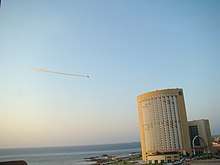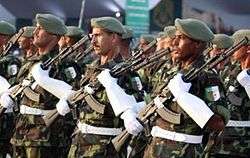40th anniversary of the Libyan Revolution
The 40th anniversary of the Libyan Revolution was a ruby jubilee anniversary in the Great Socialist People's Libyan Arab Jamahiriya celebrated on 1 September 2009 in honor of the 1969 Libyan coup d'état.[1][2][3]

Background

The coup, known officially as the al-Fateh Revolution was carried out by group of military officers led by Colonel Muammar Gaddafi known as the Free Officers Movement. The goal of this group was to contribute to the overthrow of King Idris of Libya. On 1 September, 70 army officers and enlisted soldiers who mostly came from the Libyan Army Corps of Signals launched a seizure of the government in Benghazi and, within two hours, gained control of the entire national government. One of the coup plotters first actions were to abolish the monarchy and proclaim the Libyan Arab Republic. Institutions that were later created such as the Libyan People's Court were used to purge any remnants of the former regime. The coup was the result of a continuous rise in ideologies such as Nasserism, Arab nationalism and Arab socialism throughout the Islamic and particularly the Arab world. The coup transitioned the Kingdom of Libya into military state and later a socialist republic or Jamahiriya.[4]
Military parade

A military parade of troops of the African Union and te Libyan Armed Forces took place on Green Square on 1 September.[5] This marked the first day of celebrations. Troops from foreign countries took part in the parade. Unit's that represented their country included: 154th Preobrazhensky Independent Commandant's Regiment (Russia),[6][7] 26-member contingent of the Serbian Armed Forces (Serbia).[8] Musical accompaniment was provided by the Armed Forces Band, who performed the national anthem, Allahu Akbar (anthem). Music was also provided by the bands of foreign states, including the Band of the 154th Preobrazhensky Regiment as well as the bands participating in the World Military Music Festival. For the foreign section of the parade, the bands performed Russian military marches, particularly the Preobrazhensky Regiment March, Hero and Farewell of Slavianka.
Military tattoo
The World Military Music Festival took place on 2 September as a military tattoo that saw the participation of military bands and cultural groups from 16 nations and 5 continents. It was presided by Gaddafi's son Mutassim in his position as National Security Advisor of Libya.[9]
| Country | Name | Photo | Name |
|---|---|---|---|
| | Republican Guard Band | Rats of Tobruk Memorial Pipes & Drums | |
| | Military Music Band Tyrol | Egyptian Armed Forces Symphonic Band | |
| | Ethiopian National Defence Force Band | French Foreign Legion Music Band (MLE) | |
| | Band of the Mechanized Brigade "Sassari", the Sbandieratori Gubbio and the Sbandieratori Sansepolcro | Waza Afrika Troupe | |
| | Joint Band of the Libyan Armed Forces | Armed Forces of Malta Band | |
| Symphonic Band and Chorus of the Secretariat of the Navy of Mexico | Pipes & Drums of Christchurch City | ||
| | Pakistan Armed Forces Band | EMERCOM Band and the Nalmes State Academic Dance Company | |
| Principal Band of the Senegalese Armed Forces | Tunisian Army Band | ||
| Central Air Force Band | Porth Tywyn Band |
Each individual band and group had their own short performance before being brought together for massed finale. Performances included pipe band songs, the national anthem, and the massed bands leaving to a Russian tune. The performance took place on Green Square in front of an audience of invited guests and senior military officials and thousands of members of an incredibly appreciative general public.[9] The bands present also gave an additional impromptu street performance on the square.
Attendees

- Sri Lankan President Mahinda Rajapaksa[10]
- Yemeni President Ali Abdullah Saleh[11]
- President of the Dominican Republic Leonel Fernandez[12]
- Serbian President Boris Tadić[13]
- Algerian President Abdelaziz Bouteflika
- Tunisian President Zine El Abidine Ben Ali
- Venezuelan President Hugo Chavez[5]
- Sheikh Hamad Ben Khalifa Al Thani of the State of Qatar
- Sheikh Sabah Al-Ahmed Al-Jabber Al-Sabah of the State of Kuwait
- Abdualla II of Jordan
- Sudanesse President Omar Al-Bashir
- Malian President Amadou Toumane Toure
- Gambian President Yayi Jammeh
- Chadian President Idriss Deby
- Zambian President Rupiah Banda
- Nigerien President Mamadou Tandja
- Congolese President Denis Sassou Nguesso
- Burkinabe President Blaise Compaore
- President Francois Bozize of the Central African Republic
- President Jakaya Kikwete of Tanzania
- President Faure Gnassingbé of Togo
- President Yayi Boni of Benin
- President Ahmed Abdullah Sambi of the Comoros Islands
- President Mohammed Ould Abdelaziz of Mauritania
- President Pedro Pires of Cape Verde
- President Fradique Menezes of Sao Tome and Principe
- Burundian President Pierre Nkurunziza
- Prime Minister Meles Zenawi
- Filipino President Gloria Macapagal Arroyo
- Palestinian President Mahmoud Abbas
- Bosnian President Zeliko Komsic
- President George Abela of Malta
- President Filip Vujanovic of Montenegro
- Acting President of Guinea-Bissau Raimundo Pereira
- President Mohamed Abdelaziz of the Sahrawi Arab Democratic Republic
- President of the Council of State of Oman Yahya Ben Mahfoudh Al-Mundiri
- Sheikh Mansour Ben Zayyid Al Nahyan, Minister of Presidential Affairs of the United Arab Emirates
- National Security Advisor to the President of Belarus Viktor Lukashenko
- Vice President of Gabon Didjob Divungi Di Ndinge
- Vice President of Ghana John Dramani Mahama
- Vice President of Nigeria Goodluck Jonathan accompanied by former president Olusegun Obasanjo
- Vice President of Iraq Tariq Al-Hashimi
- Prime Minister of Namibia Nahas Angula
- Prime Minister of Morocco Abbas Al-Fasi
- Prime Minister of Pakistan Yousaf Raza Gillani
- Prime Minister of Lesotho Pakalitha Mosisli
- Prime Minister of Equatorial Guinea Francisco Pascual Obama Asue
- Prime Minister of Somalia Omar Sharmarke
- Prime Minister of Singapore Goh Chok Tong
- Marshal Mohammed Hussein Tantawi, Minister of Defense of Egypt
- Vice President of Liberia Joseph Boakai
- Chairman of the State Duma of Russia Boris Gryzlov
See also
References
- "The Libyan revolution turns 40". archiv.eurotopics.net. August 28, 2009.
- "Libya to mark 40th revolution anniversary CCTV-International". english.cctv.com.
- "At 40, Gaddafi's Libya Has Much to Celebrate – CSS Blog Network".
- "FACTBOX: Libya celebrates 40 years of Gaddafi rule". September 1, 2009 – via www.reuters.com.
- "Hugs from Chavez as Gaddafi's Libya reaches 40". September 1, 2009 – via www.reuters.com.
- "В Ливии празднуют День революции" – via amp.vesti.ru.
- "Кремлевский караул примет участие в параде в Ливии". vesti.ru.
- "40th anniversary of the Libyan revolution | Serbian Armed Forces". www.vs.rs.
- "World Military Music Festival". CRAIG ROBERTS.
- "40th Anniversary of Libyan Revolution | Asian Tribune". www.asiantribune.com.
- News, 26 Septemper. "President Saleh arrives in Libya to take part in the 40th anniversary of the libyan revolution". 26sep.net.
- Libre, Diario. "Leonel reaches Libya for African Summit". www.diariolibre.com.
- "Tadić attends Libyan revolution anniversary". B92.net.